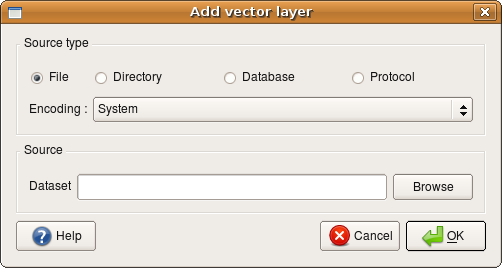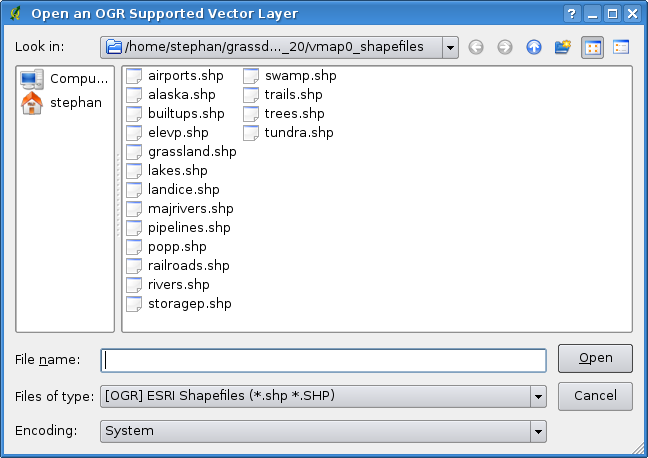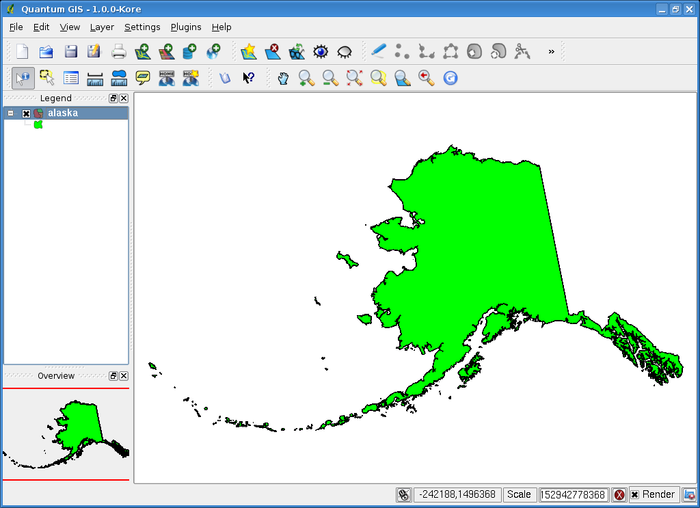「ESRI シェープファイル」の版間の差分
(→Shapefileのロード) |
(→Shapefileのロード) |
||
| 行79: | 行79: | ||
一度ロードされるとshapefileのズームはナビゲーションツールで実行できます。 | 一度ロードされるとshapefileのズームはナビゲーションツールで実行できます。 | ||
レイヤの描画方法を変更する場合は{{Template:Dialog|Layer Properties}}ダイアログをレイヤ名ダブルクリックか凡例 | レイヤの描画方法を変更する場合は{{Template:Dialog|Layer Properties}}ダイアログをレイヤ名ダブルクリックか凡例 | ||
| − | 右ボタンポップアップメニューで{{Template:DropMenuOpt|Properties}}を選択してください。セクション[[The_Vector_Properties_Dialog:Symbology_Tab|5.4.2]] | + | 右ボタンポップアップメニューで{{Template:DropMenuOpt|Properties}}を選択してください。セクション[[The_Vector_Properties_Dialog:Symbology_Tab|5.4.2]] を参照するとベクタレイヤのシンボロジ設定についてさらなる情報があります。 |
| − | + | ||
<!-- | <!-- | ||
2009年9月14日 (月) 20:46時点における版
目次
ESRI シェープファイル
QGISで使う標準的なベクトルファイル形式はESRI Shapefileです。ShapefileはOGRの Simple Feature Library( http://www.gdal.org/ogr/ ) の機能を利用してサポートされてます。実際にはshapefileはいくつかのファイルで構成されています。以下の3種類のファイルは必須で必要です:
- .shp ファイルには知物の幾何情報が格納されています。
- .dbf ファイルには属性情報がdBase形式で格納されています。
- .shx インデックスファイルです。
Shapefiles には.prj という拡張子のファイルもあります。このファイルには投影情報が格納されます。
投影情報ファイルはとても便利ですが、このファイルの利用は必須ではありません。
shapefileのデータセットは様々な追加ファイルを持てます。詳細についてはESRIテクニカルスペシフィケーション http://www.esri.com/library/whitepapers/pdfs/shapefile.pdf を参照してください。
Shapefileのロード
![]() shapefileをロードするためにはQGISを開始した後にツールば
ボタン
shapefileをロードするためにはQGISを開始した後にツールば
ボタン![]() Add a vector layerをクリックするかVをキーボード入力してください。そうすると(see Figure5)の新規ウィンドウが表示されます。
Add a vector layerをクリックするかVをキーボード入力してください。そうすると(see Figure5)の新規ウィンドウが表示されます。
指定可能なオプションファイルをチェックします。ブラウズをクリックします。 そうすると標準的なファイルダイアログが表示されます(6参照) そこではファイルシステムの中を探してshapefileかサポートされているデータソースをロードできます。 選択ボックスのファイルのtype..でいくつかのOGRで利用できるファイル形式をあらかじめ選択できます。
| 図 5: Add Vector Layer Dialog |
 |
必要があればshapefileのエンコーディングタイプ(文字コード)を指定できます。
shapefileをリストから選択してOpenをクリックするとQGISにロードできます。 Figure 7はalaska.shpをQGISにロードした後の図です。
Tip 8
地図にレイヤを追加した時にはランダムな色で描画されます。複数のレイヤを一度に追加した場合はそれぞれのレイヤ は異なる色で描画されます。
一度ロードされるとshapefileのズームはナビゲーションツールで実行できます。
レイヤの描画方法を変更する場合はLayer Propertiesダイアログをレイヤ名ダブルクリックか凡例
右ボタンポップアップメニューでPropertiesを選択してください。セクション5.4.2 を参照するとベクタレイヤのシンボロジ設定についてさらなる情報があります。
パフォーマンスの改善
To improve the performance of drawing a shapefile, you can create a spatial index. A spatial index will improve the speed of both zooming and panning. Spatial indexes used by QGIS have a .qix extension.
Use these steps to create the index:
- Load a shapefile.
- Open the Layer Properties dialog by double-clicking on the
shapefile name in the legend or by right-clicking and choosing Properties from the popup menu.
| 図 6: Open an OGR Supported Vector Layer Dialog |
 |
- In the tab General click the Create Spatial Index button.
MapInfo Layerのロード
To load a MapInfo layer, click on the
![]() Add a vector layer
toolbar bar button or type V, change the file type filter to
Files of Type [OGR] MapInfo (*.mif *.tab *.MIF *.TAB)
Add a vector layer
toolbar bar button or type V, change the file type filter to
Files of Type [OGR] MapInfo (*.mif *.tab *.MIF *.TAB) ![]() and select the layer you want to load.
and select the layer you want to load.
ArcInfo Binary Coverageのロード
To load an ArcInfo binary coverage click on the
![]() Add a vector layer
toolbar button or type V to open the
Add Vector Layer dialog. Select
Add a vector layer
toolbar button or type V to open the
Add Vector Layer dialog. Select ![]() Directory. Change to Type Arc/Ingo Binary Coverage
Directory. Change to Type Arc/Ingo Binary Coverage ![]() .
Navigate to the directory that contains the coverage files and select it.
.
Navigate to the directory that contains the coverage files and select it.
| 図 7: QGIS with Shapefile of Alaska loaded |
 |
Similarly, you can load directory based vector files in the UK National Transfer Format as well as the
raw TIGER Format of the US Census Bureau.